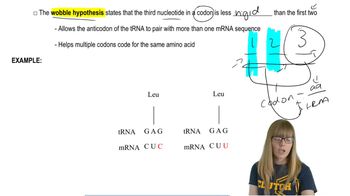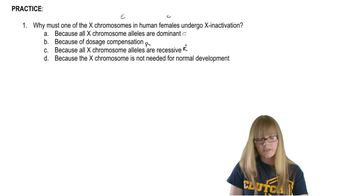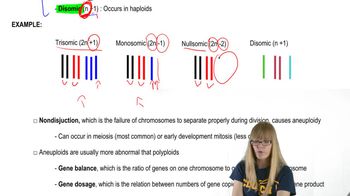Table of contents
- 1. Introduction to Genetics51m
- 2. Mendel's Laws of Inheritance3h 37m
- 3. Extensions to Mendelian Inheritance2h 41m
- 4. Genetic Mapping and Linkage2h 28m
- 5. Genetics of Bacteria and Viruses1h 21m
- 6. Chromosomal Variation1h 48m
- 7. DNA and Chromosome Structure56m
- 8. DNA Replication1h 10m
- 9. Mitosis and Meiosis1h 34m
- 10. Transcription1h 0m
- 11. Translation58m
- 12. Gene Regulation in Prokaryotes1h 19m
- 13. Gene Regulation in Eukaryotes44m
- 14. Genetic Control of Development44m
- 15. Genomes and Genomics1h 50m
- 16. Transposable Elements47m
- 17. Mutation, Repair, and Recombination1h 6m
- 18. Molecular Genetic Tools19m
- 19. Cancer Genetics29m
- 20. Quantitative Genetics1h 26m
- 21. Population Genetics50m
- 22. Evolutionary Genetics29m
6. Chromosomal Variation
Chromosomal Mutations: Aneuploidy
Problem 17c
Textbook Question
Define the Lyon hypothesis.
 Verified step by step guidance
Verified step by step guidance1
The Lyon hypothesis, also known as X-inactivation, is a process that occurs in female mammals where one of the two X chromosomes is randomly inactivated during early embryonic development.
This inactivation ensures that females, like males, have one functional copy of the X chromosome in each body cell, balancing the dosage of X-linked genes between males and females.
The inactivated X chromosome condenses into a structure known as a Barr body, which is transcriptionally inactive.
The choice of which X chromosome (maternal or paternal) to inactivate is random in each cell, leading to a mosaic pattern of X-linked gene expression in females.
This hypothesis was proposed by Mary F. Lyon in 1961 and explains phenomena such as the coat color patterns in calico cats, which are female and exhibit different colors due to X-inactivation.
Recommended similar problem, with video answer:
 Verified Solution
Verified SolutionThis video solution was recommended by our tutors as helpful for the problem above
Video duration:
1mPlay a video:
Was this helpful?
Key Concepts
Here are the essential concepts you must grasp in order to answer the question correctly.
Lyon Hypothesis
The Lyon hypothesis, also known as X-inactivation, is a genetic phenomenon that occurs in female mammals where one of the two X chromosomes is randomly inactivated during early embryonic development. This process ensures dosage compensation between males (who have one X chromosome) and females (who have two). The inactivated X chromosome condenses into a structure called a Barr body, which is largely transcriptionally inactive.
Recommended video:
Guided course

Translation:Wobble Hypothesis
Dosage Compensation
Dosage compensation is a biological mechanism that balances the expression of genes on sex chromosomes between males and females. In mammals, this is achieved through X-inactivation, where one X chromosome in females is silenced to prevent an overexpression of X-linked genes. This ensures that both sexes have a similar level of gene expression from their X chromosomes, which is crucial for normal development and function.
Recommended video:
Guided course

Purpose of X Inactivation
Barr Body
A Barr body is the inactive X chromosome in a female cell, which becomes highly condensed and transcriptionally inactive after X-inactivation. This structure can be observed in the nuclei of female somatic cells and serves as a visual marker of X-inactivation. The presence of Barr bodies is a key feature in understanding the Lyon hypothesis and the mechanisms of dosage compensation in mammals.
Recommended video:
Guided course

Other Chromatin Modifications
Related Videos
Related Practice




